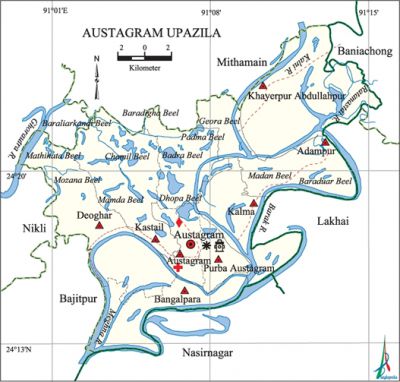Austagram Upazila
Austagram Upazila (kishoreganj district) area 300.44 sq km, located in between 24°13' and 24°27' north latitudes and in between 90°59' and 90°15' east longitudes. It is bounded by mithamain upazila on the north, nasirnagar upazila on the south, lakhai upazila on the east, bajitpur upazila on the west.
Population Total 145552; male 74580, female 70972; Muslim 123116, Hindu 22347, Buddhist 16 and others 73.
Water bodies Main rivers: meghna, barak, Kalni, Ghorautra; noted beels: Padma, Topa, Bandra, Chamil, Mamda, Matihata, Dhopa, Mojana, Balian and Monkhola beel.
Administration Austagram Thana was formed in 1905 and it was turned into an upazila in 1983.
| Upazila | ||||||||
| Municipality | Union | Mouza | Village | Population | Density (per sq km) | Literacy rate (%) | ||
| Urban | Rural | Urban | Rural | |||||
|
- |
7 |
59 |
82 |
15550 |
130002 |
484 |
37.9 |
37.3 |
| Upazila Town | ||||||||
|
Area (sq km) |
Mouza |
Population |
Density (per sq km) |
Literacy rate (%) | ||||
|
2.15 |
1 |
15550 |
7232 |
37.9 | ||||
| Union | ||||
| Name of union and GO code | Area (acre) | Papulation | Literacy rate (%) | |
| Male | Female | |||
|
Adampur 11 |
9386 |
11391 |
11045 |
35.38 |
|
Austagram 23 |
12699 |
16495 |
15353 |
41.83 |
|
Kalma 59 |
7062 |
5509 |
5735 |
46.94 |
|
Kastail 71 |
11139 |
8158 |
7375 |
30.32 |
|
Khayerpur Abdullahpur 83 |
15397 |
15175 |
14197 |
34.96 |
|
Deoghar 47 |
11290 |
10221 |
9920 |
36.58 |
|
Bangal Para 35 |
7042 |
7631 |
7347 |
36.29 |
Source Bangladesh Population Census 2001, Bangladesh Bureau of Statistics.

Archaeological heritage and relics Stone Mosque (c. 1446, Kastail), Kutub Mosque (c. 16 century).
History of the War of Liberation On 3 September 1971 the Pak army, in collaboration with the rajakars brutally killed 35 persons of Hindu community at village Ikardia. On 5 September they also killed 25 members of the Hindu community at village Savianagar.
Religious institutions Mosque 82, temple 13, tomb 12, Akhra 21.
Literacy rate and educational institutions Average literacy 37.4%; male 42.5% female 32.0%.
Newspapers and Periodicals Magazines: Shubechha, Surjatopa and Anirban.
Cultural organizations Library 1,' officers' club 1, playground 30.
Main sources of income Agriculture 82.40%, non-agricultural labourer 2.52%, industry 0.27%, commerce 7.52%, transport and communication 0.29%, service 1.91%, construction 0.31%, religious service 0.24%, rent and remittance 0.04% and others 4.50%.
Ownership of agricultural land Landowner 66.18%, landless 33.82%; ownership of agricultural land: urban 56.38% urban 67.51%.
Main crops Paddy, potato, mustard,' peanut, garlic, onion, chilli, turmeric, coriander.
Extinct or nearly extinct crops Jute.
Main fruits Mango, jackfruit, banana, blackberry, papaya.
Communication facilities Roads: pucca 7.80 km and mud road 263.13 km.
Extinct or nearly extinct Traditional transport palanquin, horse carriage and bullock cart.
Hats, bazars and fairs The most noted hats and bazars are Austagram, Purbo Austagram, Sharifanagar, Kastail, Bangal Para, Adampur, Kalma, Khayerpur Abdullahpur and Chhaudamadal Mela at Bangal Para (largest mela of the bhati region).
Main exports Paddy, potato, peanut, banana, papaya.
Access to electricity All the unions of this Upazila are under rural electrification net-work; however, 12.56% dwelling households have access to electricity.
Sources of drinking water Tube-well 93.17%, pond 1.77%, tap 0.67% and others 4.39%.
Sanitation 13.85% (urban 13.24% and rural 18.35%) of dwelling households of the upazila use sanitary latrines and 76.75% (urban 78.36% and 64.90%) of dwelling houses use non-sanitary latrines; 9.40% of households do not have latrine facilities.
Health centres Upazila health complex 1, union health and family planning centre 7, rural health centre 1.
NGO activities brac, proshika, ICDC, Ganaunnyan, Bandhon Society, Chetana. [Enayet Sobhan]
References Bangladesh PopulaAtion Census 2001, Bangladesh Bureau of Statistics; Cultural survey report of Austagram Upazila 2007.
